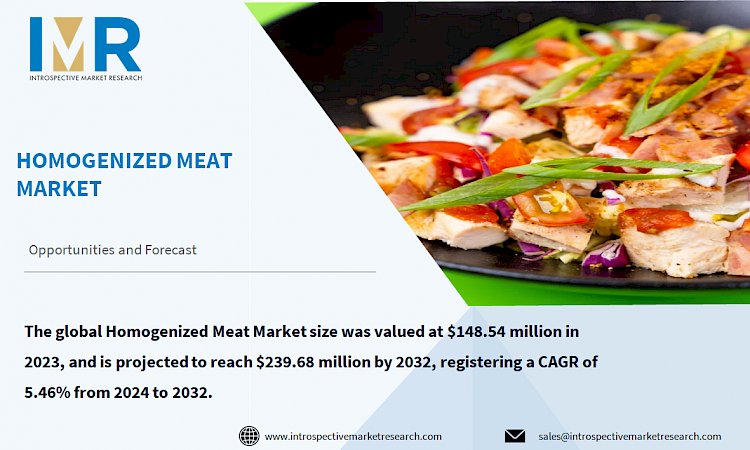Homogenized Meat Market
According to a new report published by Introspective Market Research, titled, “Homogenized Meat Market by Product Type, end-users, Distribution Channel: Global Opportunity Analysis and Industry Forecast, 2024–2032,”
the global Homogenized Meat Market size was valued at $148.54 million in 2023, and is projected to reach $239.68 million by 2032, registering a CAGR of 5.46% from 2024 to 2032.
Homogenized meat products aim to provide the child with biologically valuable proteins that come entirely from meat. The product must be stored in a dry place, away from heat sources. If the product is not completely consumed, it must be sealed, stored in the refrigerator, and used within 24 hours. Homogenized meat is widely demanded in several foods such as baby foods, spreads, pâtés, sausages, and convenience foods. These products meet a variety of consumer needs, providing convenient and healthy options for babies, busy professionals, and the elderly who need easily digestible foods. The adaptability of homogenized meat allows it to be combined with various cooking designs, improving taste and texture and ensuring reliability in every bite. Homogenized meat has many advantages. This suggests a long shelf life, making it the right choice for customers and sellers. The homogenization process ensures a uniform composition and quality, which is especially important for products such as baby food and creams. Homogenized meat products are often supplemented with important nutrients that enhance health benefits. This makes them a valuable addition to diets where nutritional value is important.
According to the Homogenized Meat Market is segmented into Product Type, End-User, Distribution Channel, and Region. By Product Type, the market is categorized into Beef, Pork, Chicken, and Mixed. By End-User, the market is categorized into Household Consumption, Food Service Industry, and Food Processing Industry. By Distribution Channel, the market is categorized into Supermarkets \ Hypermarkets and Specialty Stores. By region, it is analyzed across North America (U.S.; Canada; Mexico), Eastern Europe (Bulgaria; The Czech Republic; Hungary; Poland; Romania; Rest of Eastern Europe), Western Europe (Germany; UK; France; Netherlands; Italy; Russia; Spain; Rest of Western Europe), Asia-Pacific (China; India; Japan; Southeast Asia, etc.), South America (Brazil; Argentina, etc.), Middle East & Africa (Saudi Arabia; South Africa, etc.).
Customer demand for prepared meals is an important factor in the homogenized meat market, which significantly contributes to its growth and expansion. Modern life, characterized by busy schedules and limited time to prepare meals, has led to an increase in the popularity of edible and easy-to-prepare foods. Homogenized meat products meet this demand by providing a quick and convenient source of protein that fits the busy lifestyles of today's consumers. The demand for convenience foods is based on their ability to save time and effort in the kitchen while providing nutritious and satisfying meals. Homogenized meat with a consistent texture and reliable quality can be easily added to various dishes, making food preparation both efficient and versatile. This convenience appeals to working professionals, students, and families with busy schedules who are looking for nutritious meals without the superior prep time usually associated with home cooking.
Growing health awareness among consumers and the growth of the homogenized meat market. People have become more aware of the importance of a balanced diet and better food choices, and the demand for meat products with reliable quality and better nutritional value is increasing. Homogenized meat, which ensures a uniform texture and distribution of fat and nutrients, perfectly matches the preferences of these customers, providing a reliable source of protein and essential nutrients. The increasing importance of food safety and hygiene increases the acceptance of homogenized meat products. Consumers are increasingly looking for products that meet high processing and packaging standards to ensure their safety and health. The production of homogenized meat involves complex quality control measures that reduce the risk of contamination and ensure the safety of consumption of the final product. This focus on safety and quality resonates with health-conscious consumers, fueling market growth.
Global Homogenized Meat Market, Segmentation
The Homogenized Meat Market is segmented based on Product Type, end-users, Distribution Channel, and region.
Product Type:
The Product Type segment is further classified into Beef, Pork, Chicken, and Mixed. Among these, the Beef sub-segment accounted for the highest market share in 2023. Growing consumer preference for high protein diets associated with the nutritional value and flavor profile of beef is increasing its popularity. The development of food processing technology has improved the quality and stability of Homogenized beef products, which meet the convenience and quality of consumers. The beef segment of the homogenized meat market will benefit from evolving consumer lifestyles. Busy schedules and changing eating habits make consumers look for convenient yet nutritious meal options, for which homogenized beef products are perfect. The versatility of beef as an ingredient enhances its appeal, allowing producers to modernize and introduce a diverse range of homogenized meat products to suit different cooking needs and habits.
End-User:
The End-User segment is further classified into Household Consumption, Food Service Industry, and Food Processing Industry. Among these, the Food Service Industry sub-segment is anticipated to show the fastest growth by 2032. This segment offers a wide range of settings including restaurants, fast food, catering services, and commercial kitchens. The demand for homogenized meat products in the food service industry is driven by many factors, including consumer preferences for convenient and prepared meat options, especially in high-traffic urban areas where fast food is in high demand. The development of the homogenized meat segment in the food industry is also driven by technological advances and innovations in food processing techniques. Manufacturers are constantly striving to improve the quality, taste, and preservation of homogenized meat products to meet the strict standards of food establishments. This includes developing custom mixes and formulations tailored to the specific needs of chefs and caterers.
Region:
The Homogenized Meat Market in Asia-Pacific is projected to show the fastest growth by 2032. The region has several countries with different cooking habits, economic conditions, and consumer behavior, making it an active and profitable market for homogenized meat products. The demand for food service convenience and quality in the Asia-Pacific region is fueling the growth of homogenized meat, as consumers increasingly opt for prepared and time-saving meat solutions. The homogenized meat market position in the Asia-Pacific region remains driven by factors such as urbanization, changing lifestyles, and the growth of modern retail formats. In urban areas with densely populated cities, there is a greater demand for packaged and readily available food options and homogenized meat products suitable for fast-paced lifestyles.
Some of The Leading/Active Market Players Are-
- Tyson Foods Inc. (United States)
- JBS S.A. (Brazil)
- Cargill, Incorporated (United States)
- WH Group Limited (China)
- Hormel Foods Corporation (United States)
- Conagra Brands, Inc. (United States)
- OSI Group LLC (United States)
- Maple Leaf Foods Inc (Canada)
- Danish Crown A/S (Denmark)
- Tonnies Lebensmittel GmbH & Co. KG (Germany) and Other Active Players
Key Industry Developments
- In February 2024, Cargill, a global leader in food and agriculture, expanded its portfolio with the acquisition of two cutting-edge case-ready meat plants located in North Kingstown, RI, and Camp Hill, PA, from Infinity Meat Solutions, a subsidiary of Ahold Delhaize USA. The financial terms of the transaction remain undisclosed. The North Kingstown facility, spanning 209,000 square feet and operational since October 2020, significantly enhances Cargill's meat processing capabilities, while the Camp Hill plant, employing 800 professionals and capable of producing up to 2 million pounds of beef and pork products weekly, strengthens its position in the case-ready meat segment.
- In October 2023, Tyson Foods, Inc. entered a transformative agreement with Protix, the leading global insect ingredients company, marking a significant step towards advancing sustainable food solutions. This strategic collaboration, supported by a two-fold investment, combines Tyson Foods’ global scale, experience, and network with Protix’s technology and market leadership to drive innovation in the food industry. Together, they aim to scale production and expand the use of insect ingredient solutions, creating more efficient and sustainable proteins and lipids for the global food system. This partnership reflects Tyson Foods’ commitment to sustainability and its proactive approach to meet evolving market demands while fostering long-term environmental stewardship.
Key Findings of the Study
- The global Homogenized Meat Market was valued at $148.54 million in 2023 and is projected to reach $239.68 million by 2032, with a CAGR of 5.46% from 2024 to 2032.
- Increasing consumer demand for convenient, nutritious meals and growing health awareness are key drivers of market growth.
- The market is segmented by product type, with beef accounting for the highest share in 2023, and by end-users, with the food service industry anticipated to show the fastest growth by 2032.
- The Asia-Pacific region is expected to exhibit the fastest growth in the market, driven by urbanization, changing lifestyles, and the expansion of modern retail formats.





